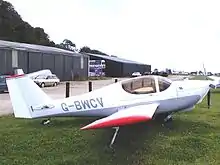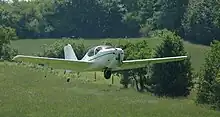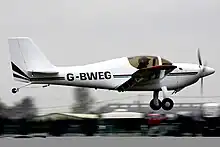Europa XS
The Europa XS and Europa Classic are a family of British composite two-place low-wing monoplane kit aircraft. Designed by Ivan Shaw, the Europa was introduced in the early 1990s. Europas are manufactured by Europa Aircraft and supplied as kits for amateur construction. More than 450 Europas have been completed.
| Europa XS series | |
|---|---|
 | |
| Role | Kit aircraft |
| National origin | United Kingdom |
| Manufacturer | Europa Aircraft |
| Designer | Ivan Shaw[1] |
| First flight | 12 September 1992[2] |
| Produced | 1994[2]-present |
| Number built | 495 by 2011[3] |
| Variants | Liberty XL2 |




The Europa was conceived as a modern kit aircraft for personal use within Europe. Its design aims were: high speed, low cost, able to be built and stored at home, easily transportable on a trailer, using Mogas fuel, able to be rigged for flight in under five minutes, carrying two people in comfort, and providing sufficient baggage for extended touring. Apart from "low cost", these objectives were largely met.[4]
Development
Ivan Shaw's design work on the Europa, as it was initially named, began in January 1990. The first prototype, G-YURO, first flew on 12 September 1992 and Popular Flying Association certification was gained in May 1993. Most Europas have been sold in kit form, although five factory-assembled aircraft were produced between 1994 and 1996. The first kit-built aircraft to be completed flew on 14 October 1995.[2] By the autumn of 2007 450 Europas of all types had been completed and were flying.[5]
The basic design was later developed by Ivan Shaw into a United States FAR certified aircraft, built by Liberty Aerospace in the US as the Liberty XL2.
The Europa is classified as a homebuilt in its home country of the UK and qualifies for a Permit to Fly. This limits it to day and VFR flight. Previous restrictions of flying over built up areas were removed during 2008. In Canada the Europa is an amateur-built aircraft and qualifies for a Special Certificate of Airworthiness.[6]
In 1997 UK Prime Minister Tony Blair launched the Millennium Products competition to promote British industry in the 21st Century.[7] This culminated in 1999 with a winners list of 1012 manufacturers and their products. One of these was the Europa XS, described as "A light aircraft which offers speed, economy and performance and can be stored on a trailer in your garage."[8]
Europas are flown in Europe in the very light aircraft category. In the United States the Europa XS is currently awaiting light-sport aircraft certification and as of April 2017 the design does not appear on the Federal Aviation Administration's list of approved special light-sport aircraft.[9][10]
Design
The streamlined composite design and the particularly low canopy give the Europa both high cruise speeds of 200 mph (320 km/h) and fuel efficiency of 50 mpg‑imp (5.6 L/100 km) due to its low drag.[11] The Europa can be fitted with Rotax 912UL of 80 hp (60 kW), the 100 hp (75 kW) Rotax 912ULS or the turbocharged 115 hp (86 kW) Rotax 914 engine.[11]
Europas first became available with a monowheel landing gear and a tailwheel. The wings had small castors on outriggers that were lowered with the flaps.[11] Shaw chose the monowheel configuration for its perceived advantages of reduced weight and improved performance over a tricycle configuration. In practise, the monowheel Europa proved tricky in inexperienced hands and could be prone to prop-strikes and groundlooping (partly due to the lack of differential braking) so the company developed a tricycle undercarriage which has become the more popular version, particularly as any performance disadvantage has been slight.
Europas can be fitted with either normal (tourer) wings made out of fiberglass, with 102 sq ft (9.5 m2) wing area and 13.43 lb/ft2 wing loading at MTOW, or motorglider wings, made from carbon fiber with a greater span. Since the fuselage is common to both motorglider and tourer then with both sets of wings the same fuselage can be configured as a tourer and a motorglider alternately. The wings can be removed for transportation or storage in five minutes.[11]
The Europa touring wing uses a unique Dykins 12% thickness/chord ratio airfoil designed by Don Dykins, who had been deputy Chief Aerodynamicist at Hawker Siddeley Aviation, and later technical director of British Aerospace and chief aerodynamicist on the European Airbus.[12]
The motorglider wing uses a different wing section, also designed by Dykins, with its center of pressure coincident with that of the smaller wing to ensure that the rudder and tailplane are equally effective with either. Wingspan is increased to 42 feet (13 m) bringing the wing area to 135 sq ft (12.5 m2). The motorglider wings are fitted with airbrakes rather than flaps.[13]
Development is also under way for wings suitable for a light-sport aircraft variant of Europa XS.[14]
The fuel tanks are located in the fuselage and have a capacity of 18 U.S. gallons (68 L; 15 imp gal) standard and 28 U.S. gallons (110 L; 23 imp gal) optional. This gives a range of 841 mi (1,353 km) standard or 1,256 mi (2,021 km) extended at economy cruise setting.[11] The plane can use AVGAS or MOGAS depending on engine requirements and national regulations. It is also possible to upgrade fuel capacity with the addition of extra fuel tanks.
Variants
- Europa Classic
- Originally called simply "Europa", this version is now known as the Classic and is easily recognised by its monowheel undercarriage. Kits for amateur building are no longer in production. The laminar-flow wings have foam cores that are skinned with glass fibre cloth and resin.[15] Some elements of the later Europa XS can be incorporated into a Classic and vice versa.[16] Europa builders invariably purchased the kit in stages, so some who had completed the fuselage were able to then opt for the quick-build Europa XS wings.
- Europa XS
- Introduced in 1997,[2] the Europa XS is available in two models – the Europa XS Monowheel and the Europa XS Trigear. The XS incorporates many incremental improvements over the Classic, including preformed hollow wings, a more streamlined cowling, extended tailwheel, enlarged baggage bay, and a smaller spinner that was easier to balance. These developments meant that Europa XS still fulfils the original design objectives, but now offers extra speed, range, baggage space and comfort. It was also designed to reduce the build-time and simplify building.[11][17][18]
- Europa Motorglider
- Introduced in 1997.[2] Long span glider wings can be interchanged with the wings on the Europa XS Monowheel and Trigear.[19][20]
- Europa LSA
- The Europa light-sport aircraft has a new carbon fibre wing incorporating a leading-edge slot. The result is a wing weight reduction of 30%. It reduces the maximum takeoff weight to 1,320 lb (599 kg) with an empty weight of 520 lb (236 kg), giving a slightly increased payload.[17][18][21] A concept version appeared at Sun 'n Fun in May 2010 and the production aircraft debuted at AirVenture 2012.[22] The LSA was launched in the US at Sun n Fun April 2011.[23][24] As of April 2017, the design does not appear on the Federal Aviation Administration's list of approved special light-sport aircraft.[10]
- Europa Taildragger
- Some Europas with conventional taildragger configuration have been built. These are not "factory" versions, but they do have LAA approval. They are said to have easier handling than the monowheel version.
Accidents
On 1 June 2007 a Europa Classic, registration G-HOFC, broke up during a flight over South Wales, United Kingdom, killing both occupants. The investigation indicated irregularities in the construction of the right wing attachment at the rear lift/drag pin. There was also evidence of movement of the tailplane surfaces beyond the normal range of movement.
As a result of the initial findings, the Light Aircraft Association released two Airworthiness Bulletins requiring immediate and repetitive inspections:[25]
- PFA 247/FSB006 ‘Europa Classic and Europa XS Tailplane Flutter Avoidance and Integrity Of Tailplane Attachment’
- PFA 247/FSB007 ‘Europa Classic Integrity of Wing Attachment’.
The content of these Airworthiness Bulletins was made mandatory in the UK by the issue of Mandatory Permit Directives. The final accident report concludes that these modifications and the mandated inspections of aircraft already completed, adequately address the construction issue.[26] This accident affects only Europa Classics, all of which should have now been modified, and not the XS model which has a different structure.
Aircraft on display
- Yorkshire Air Museum - prototype Europa G-YURO, painted in its Millennium Product colours.[27][28]
Specifications (Europa XS, tricycle undercarriage)
Data from Jane's All The World's Aircraft 2003–2004[29]
General characteristics
- Crew: 2
- Length: 5.84 m (19 ft 2 in)
- Wingspan: 8.28 m (27 ft 2 in)
- Height: 2.13 m (7 ft 0 in)
- Wing area: 9.48 m2 (102 sq ft)
- Aspect ratio: 7.2:1
- Empty weight: 354 kg (780 lb)
- Gross weight: 623 kg (1,370 lb)
- Powerplant: 1 × Rotax 912 ULS , 74 kW (99 hp)
Performance
- Cruise speed: 250 km/h (155 mph, 135 kn)
- Range: 1,355 km (732 mi, 636 nmi)
- Rate of climb: 5.1 m/s (1,000 ft/min)
See also
Aircraft of comparable role, configuration, and era
References
- "Flyer" magazine, 19 Jun 2006 Archived 22 November 2010 at the Wayback Machine
- Jackson 1999
- Vandermeullen, Richard: 2011 Kit Aircraft Buyer's Guide, Kitplanes, Volume 28, Number 12, December 2011, page 51. Belvoir Publications. ISSN 0891-1851
- Europa Aircraft (2011). "About". Retrieved 3 August 2011.
- Kitplanes Staff: 2008 Kit Aircraft Directory, page 50, Kitplanes Magazine December 2007 Volume 24, Number 12, Belvior Publications, Aviation Publishing Group LLC.
- Transport Canada Website - EXEMPTION FROM SECTION 549.01 OF THE CANADIAN AVIATION REGULATIONS AND CHAPTER 549 of THE AIRWORTHINESS MANUAL – AIRWORTHINESS STANDARDS - AMATEUR-BUILT AIRCRAFT 2 February 2005, accessed 19 September 2007 Archived 12 March 2008 at the Wayback Machine
- "Tony Blair Unveils Final Millennium Products". PR Newswire. Retrieved 13 January 2013.
- "Millennium Products list" (PDF). Archived from the original (PDF) on 19 July 2011. Retrieved 5 April 2011.
- Experimental Aircraft Association (2011). "Special Light-Sport Aircraft". Archived from the original on 28 February 2014. Retrieved 3 August 2011.
- Federal Aviation Administration (1 March 2017). "SLSA Make/Model Directory". Retrieved 4 April 2017.
- Europa Aircraft (2004) Ltd. "Product Specifications". Archived from the original on 3 February 2008. Retrieved 31 October 2007.
- Lednicer, David (October 2007). "The Incomplete Guide to Airfoil Usage". Archived from the original on 15 May 2008. Retrieved 17 August 2008.
- 'Kitplanes' magazine, July 1999
- Europa Aircraft. "Europa Aircraft - Europa LSA (Light Sport Aircraft)". europa-aircraft.co.uk. Retrieved 29 May 2016.
- Europa Club, Classic Build Manuals Archived 20 August 2016 at the Wayback Machine, retrieved 29 May 2016
- LAA Type Acceptance Data Sheet - TADS 247 & 247a Europa, Europa XS & Europa NG, retrieved 29 May 2016
- Bayerl, Robby; Martin Berkemeier; et al: World Directory of Leisure Aviation 2011-12, page 101. WDLA UK, Lancaster UK, 2011. ISSN 1368-485X
- Tacke, Willi; Marino Boric; et al: World Directory of Light Aviation 2015-16, page 106. Flying Pages Europe SARL, 2015. ISSN 1368-485X
- Europa Company Brochure
- "Latest & most up-to-date aviation information - Pilot Magazine". Pilot. Archived from the original on 8 February 2005. Retrieved 29 May 2016.
- "Europa LSA". Retrieved 5 April 2011.
- "Europa LSA Sun n Fun 2010". Archived from the original on 21 February 2011. Retrieved 5 April 2011.
- "Europa LSA Sun n Fun 2011". europa-aircraft.com. Retrieved 5 April 2011.
- Bernard, Mary and Suzanne B. Bopp: Europa Aircraft: Europa XS LSA Trigear, Kitplanes, Volume 29, Number 12, December 2012, page 25. Belvoir Publications. ISSN 0891-1851
- AAIB Report on the 1 June 2007 Europa Accident
- "AAIB Bulletin: 5/2008 G-HOFC" (PDF). Archived from the original (PDF) on 23 October 2008. Retrieved 17 August 2008.
- Ellis 2010 p.262
- Yorkshire Air Museum. "Europa Prototype". Retrieved 3 August 2011.
- Jackson 2003, pp. 489–490.
- Ellis, Ken (2010). Wrecks & Relics (22 ed.). Manchester: Crecy. ISBN 978-0-85979-150-2.
- Jackson, Paul (1999). Jane's All the World's Aircraft 1999-2000. Coulsden, UK: Jane's Information Group. ISBN 0-7106-1898-0.
- Jackson, Paul (2003) Jane's All The World's Aircraft 2003–2004. Coulsdon, UK: Jane's Information Group. ISBN 0-7106-2537-5.